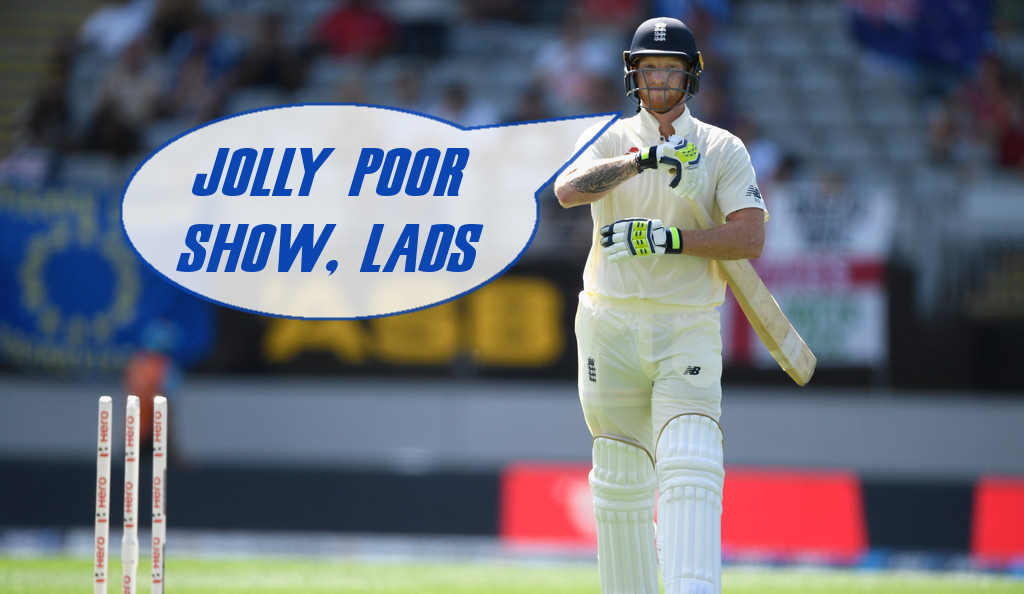Stat Attack – 58 All Out
Well now that was unexpected. The only thing crazier than the Blackcaps skittling the English for 58 is the idea that we could be disappointed at the end of it that the Cappies didn’t slice them off for less. Kane Williamson won the toss and elected to bowl, hoping to get something out of the wicket early on. Joe Root said he’d have batted anyway in the expectation of getting two good sessions in before the lights came on. 94 minutes later they were having an early lunch and preparing to bowl.
At 23/8 and then 27/9 we were poised for an even greater set of records. That infamous day back in 1955 when the New Zealand cricket team were bowled out – by England at Eden Park! – for 26 was suddenly back in the thoughts. A dark day in kiwi cricket, an unwanted record that some said would never be beaten and yet here we were, Trent Boult and Tim Southee needing two more wickets for two more runs to top it. Until Craig Overton chopped a wide one through to the boundary for four. But then Kane Williamson took an unbelievable catch off Tim Southee’s bowling to remove Stuart Broad and the second-lowest Test total ever was still in range.
That didn’t happen either. It wasn’t even England’s lowest total in the end, nor was it the lowest New Zealand has ever bowled a team out for. Both of those records disappeared thanks to the swinging bat of Craig Overton, playing in only his third Test match. That bloke’s entire innings was an anomaly as he scored 33 off 25 balls while the entire rest of his team added only 25 from 91 balls and that’s including extras.
Overton single-handedly kept this team from a near-mythical humiliation and in the process he and Jimmy Anderson added 31 for the final wicket, more than the first nine partnerships combined. That’s something which has only been achieved three times prior and two were pretty recent. There was that wonderful day when South Africa bowled Australia out for 47 in Cape Town to win a Test in which they were bowled out for 96 themselves in their first dig. The Aussies were in an even worse position than England were, Nathan Lyon coming to the crease at 21/9 amidst an onslaught from Dale Steyn, Vernon Philander and Morne Morkel. But the man they call Garry pulled off a masterclass, adding a brilliant 14 runs to guide his team through to a 26-run final wicket stand.
The other two were sorta different situations. Australia were 117/9 in the 2013 Ashes when Ashton Agar wandered out to join Phil Hughes in the middle (RIP) and the pair put on 163 runs before the debutant Agar (who wasn’t even in the initial touring squad) was dismissed for 98. That was a world record tenth-wicket stand, since beaten by Joe Root and James Anderson against India in 2014, knocking off the legendary 151-run stand between Brian Hastings and Richard Collinge against Pakistan in Auckland in 1973. Agar’s record score of 98 at number 11 still stands though (Dick Collinge is way back in fifth with his 68*). Then the last one was a boring 117-run partnership between Peter Willey and Bob Willis in 1980 for England against the West Indies to recover from 84/9. Clearly it ain’t the same once the team passes fifty.
England’s lowest ever total slipped by when Overton lifted a six over square leg that also brought up the half-ton for the side. It took them past the 45 all out that they set against Australia in Sydney all the way back in 1887. The 25th Test match ever played by the official records. The current game at Eden Park is Test Match #2299. Back in 1994 the English were also racked for 46 in the West Indies (Curtly Ambrose took 6/24 and 11 for the match) and frustratingly there have been three other occasions of them getting done for less than 58. Wasn’t even a top five lowest English total, dammit. By the way when they got done for 45? They went on to win by 13 runs.
So keep that in mind before you launch bombs at English cricket because they were also on the bowling end of nine of the eleven lowest totals in Test cricket. One against New Zealand, four against South Africa, two against Australia and one against India. Granted the most recent of those nine was in 1974. Teams don’t get swept like that too often these days, not since tailenders started playing one-day cricket and learned how to slog. The lowest score since the mid-1970s is… drumroll… New Zealand’s 45 all out against South Africa in 2013. Kane Williamson, BJ Watling and Trent Boult all played that day.
England have bowled teams out nine times for totals lower than their worst ever batting effort, New Zealand has four batting embarrassments worse than their best bowling effort. 26 against England in 1955, 42 against Australia in 1946, 45 against South Africa in 2013 and 47 against England in 1958. Even after Overton snuck them past the 26 there was still a great opportunity to get in ahead of a couple others there, let alone NZ’s best ever bowling performance (runs-wise) which came in Napier in 2012 against Zimbabwe.
Batting first that game, both Ross Taylor and BJ Watling scored centuries and openers Brendon McCullum and Martin Guptill added half-centuries on the way to 495/7 declared. They called time on the innings before lunch on Day Three (following rain on the second day) and went in for their meals with Zimbabwe at 20/5. An hour later they were 50/8 at drinks and it didn’t take long after that to get them all out for 51. The follow-on was enforced and Chris Martin took 6/26 as Zimbabwe were then bowled out again for 143 – bowled out twice on the same day.
England’s 58/10 settles into second place on the kiwi records, one run ahead of the 59 that Zimbabwe were bowled out for in Harare in 2005 and then the 64 that England scored at the Basin in 1978 (Hadlee! Hadlee! Hadlee!). Curiously when NZ bowled ZIM out for 51 there were five different bowlers used in 28.5 overs and every one of them took a wicket (Martin 2, Boult 2, Bracewell 2, Vettori 1, Southee 2 and a run out). But on this occasion, 58 all out, only two bowlers got a go.
Trent Boult took a career best 6/32 and Tim Southee added 4/25, each bowling unchanged into the 21st over. Might sound mental that England only lasted 94 minutes at the crease but that’s an hour and a half of bowling without relief for Boult and Southee. You could see them tire as they went on, Boult in particular, and that probably contributed to Overton’s brief counter attack but at the same time it also means that they became the fifteenth pair of opening bowlers to clean a team out without any help and the first since the legendary duo of Wasim Akram and Waqar Younis who got through an insane 28.2 overs in bowling Sri Lanka out for 71 in 1994. The previous occasion before that was also Pakistan, against Australia in 1956, and the time before that was England vs South Africa in 1924. The other eleven all came prior to World War One. Think about that for a second. That’s historic, mate.
How about only batting for 20.4 overs? That’s kind of a tricky one to work out because back in the day they didn’t always stick to six-ball overs. This is mental to ponder on today but it was only in 1979/80 that all Test cricket was aligned with six-ball overs. Four, five and eight ball overs have all been in play at different times in different countries. They used to base it on the rules of the domestic stuff in the host country and Australia once pioneered the eight-ball over because they wanted more deliveries squeezed into a day’s play (fewer change-overs, basically) and New Zealand quickly followed suit. Between the 1968-69 and 1978-79 seasons the eight-ball over was the flavour in Test cricket in Aotearoa. It was ODI cricket that finally forced the alignment.
Shrink it to deliveries faced then and England’s tenth wicket fell to the 124th ball bowled. That’s the sixteenth fewest in history, the eighth fewest since the end of WW2 and the fifth fewest since the turn of the millennium. Easily the shortest completed innings from a kiwi bowling crew.
Anything else? Maybe the duck thing. Five Englishmen were dismissed for naught. Five little duckies, all in a row: Joe Root, Ben Stokes, Johnny Bairstow, Moeen Ali and Stuart Broad. It’s the fourth time that that’s happened to England and the first time since 1976 and the 39th overall (including the ICC World XI in 2005). New Zealand have been involved in 12 of those 39 Tests, six on either side. Four times there have been six ducks in an innings but none that involved Aotearoa. So shame on those jokers, s’pose.
While we’re at it, how about Joe Root’s trips to NZ? A little less hyped than Barack Obama’s, that’s for sure. (He’ll probably score a hundy next time up).
Support The Niche Cache by smacking an ad and as well as the happy feeling in your loins from having done a good deed you’ll also receive +3 karmic retribution points

